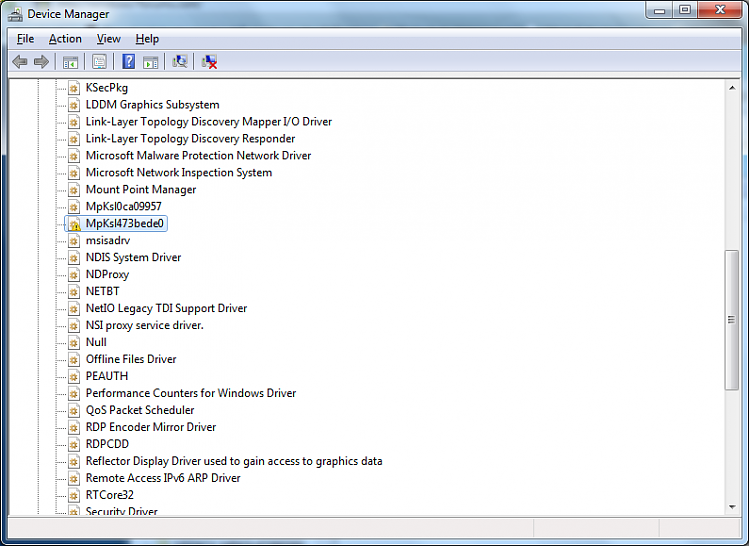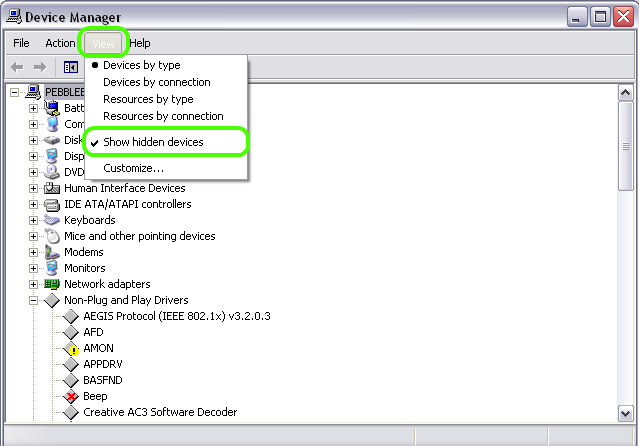According to this discussion on TechNet and me checking both Windows 8 and Windows 8.1 locally, the 'Non-Plug and Play Drivers' are no longer accessible in Device Manager in 8.x regardless of what you try. You can always just try to disable the beep driver directly: change the Start value from 1 to 4, which means disabled. Aug 21, 2017 No Soulutions availible.Non Plug and Play Drivers-Yellow Caution Symbol-Parport. Its drivers installed. Parport and Serial entries in Non Plug and Play Drivers tree something.High-Speed USB Serial Adapter optimized for Windows 10,. USB Plug and Play allows easy installation and requires no IRQ,.UPort 1130/UPort 1130I.
Download Latest Plug & Play Drivers
Over 27,000,000 Device Drivers
Update all Your Drivers in 3 minutes
What is Plug & Play Drivers ?
With old Windows versions you had to install a hardware only after switching off your computer. And if you were to plug in a hardware like your Printer into the printer port or insert your keyboard or mouse in to the slot in the back of your computer you had to restart your computer because Windows tried to recognize or search for a device driver only when you restart your PC. To avoid this unwanted PC reboot, Microsoft came up with a novel idea. USB or Universal Serial Bus was the name given. With this port you could plug in any hardware that is USB compatible into it. New versions of Windows was modified to search and recognize a USB device the moment it is plugged into the USB slot. These hardware were made in such a way that they tell Windows what hardware they are and which drivers are required to be loaded to get them working.
Automatically Update Plug and Play Drivers
But soon hardware manufacturers started making changes to their Plug and Play or USB hardware and the generic drivers that comes packed with Windows failed to run them or could not give all the designed features to the user because of the limitations of the generic device drivers. Today Windows XP/Vista and Windows 7 comes preloaded with most of the Plug and Play Device Drivers. However, some hardware like Plug and Play USB Devices, Printers, Modems, Phones, scanners, external hard disks or storage mediums like cd roms, dvd roms etc may come with their own Device Driver files. This is because the hardware manufacturer wants to give many more features than what the generic windows plug and play drivers can give your hardware. Most of the plug and play hardware works with the Windows plug and play drivers. But many of them fails to even get recognized by Windows so even the generic drivers will not get installed for them. In such cases you may have to insert the Driver CD or USB for installing the correct model specific drivers.
How Plug and Play Device Drivers get Automatically Installed?
The plug and play devices have been desingned to identity themselves to Windows immediately on being plugged into the USB port, giving their exact manufacturer, hardware type, model numbers and other details that Windows require to load the necessary generic drivers. So when you connect a plug and play device into the USB slot or other port, Windows tries to identify the hardware by sending a query to the hardware or device identifies itself to Windows by sending necessary details. This will not happen if the autorun feature is disabled on that USB or port. Also if the generic plug and play device driver is not present in Windows version installed in your PC or Laptop, then it will ask you for a location of the drivers or to insert the driver disk.
Why Update Drivers if Windows has already Installed Plug and Play Drivers?
It is advised that even if Windows installs plug and play drivers it is always better to use the Drivers that came with the hardware beacuse the Windows generic plug and play drivers are as old as Windows whereas the driver disk your hardware manufacturer provided has the better drivers. But again it is better to go to the original hardware manufacture website and download the latest drivers for your hardware. Use an Automatic Driver Download Tool to update all your Windows plug and Play drivers also.
All the changes you make are stored into your Windows Registry. A few of the registry paths where you can find your Plug and Play settings are given below.
HKEY_LOCAL_MACHINESYSTEMCurrentControlSetServices
HKEY_LOCAL_MACHINEHARDWARERESOURCEMAPPnPManager
HKEY_LOCAL_MACHINESYSTEMCurrentControlSetServicesPlugPlay
Windows Registry is where all the setting that you make or change in your computer saved into. Registry is the nerve center of your Computer without which Windows or any software that you use cannot function. Windows Registry is used by Windows and all the software that you install, remove and use every day like your word processor, your notepad, your video editor, your internet explorer etc. All of these applications read and write entries continously to the Windows registry making it larger every day. But some software write wrong entries or over write some entries made by another software or Windows itself. This causes errors that can make your PC or Laptop to Freeze or hang up and even crash with total data loss. Experts recommend using Windows Registry Cleaner to remove errors from Windows Registry because clean PC registry ensures error free, high computer performance.
How does Plug and Play Drivers run in your Computer?
Most device drivers including Plug and Play Drivers are designed to run in the Ring 0 or Kernel level. Some of the devices drivers are designed to run as File System driver, and some like Network adapter. Some Win32 Drivers can run as a service in a stand alone process and some Win32 drivers runs in a shared address space with other services at the some time. Some drivers are software enumerators. For a user it does not matter how the driver runs as long as it the correct driver for a device or hardware that has been installed, otherwise your PC may freeze up or crash at times when ever you try to use the wrong driver installed with the hardware.
Plug and Play Device Drivers start running with bootup of your PC. Some driveres that runs as a Windows service may start up only when a service is requested. For example you give a document print command. This triggers Windows to start the printer service to get executed. This may take some time. So often printer manufacturers like HP printers makes the drivers to get loaded with your PC startup itself which is actually not required. You can safely turn them off, because the moment you give print command these plug and play drivers will get loaded into your PC Memory. Some drivers are made to start automatically and some plug and play drivers may required to be started manually. But if a plug and play device is assigned the disabled code then that particular plug and play driver may not load at all. So you need to be careful when you change your group policies in Windows or editing the Windows registry settings.
At times the Plug and play hardware fails to work because of many reasons. One is that the connector is not properly inserted. Or a connector pin is bent or broken. This makes Windows unable to recognize the plug and play hardware and it fails to load the appropriate driver giving a warning 'unrecognized hardware'. Also at times Windows does recognize the hardware but does not have the correct driver available and again it may give out the same warning. Sometimes you may have pulled out the hardware without ejecting or stopping the service and Windows may be unable to locate the hardware for which the driver is already loaded into the memory which commonly happens in case of most USB drives and USB devices. This may also damage the USB devices permanently.
What is WHQL Certified or Signed Plug and Play Drivers ?
Non-plug And Play Drivers Free Download

It is always better to install Signed Windows Plug and Play Drivers because these are WHQL or Windows Hardware Quality Labs Certified Drivers. When you install unsigned drivers you may get a warning. If a signed or WHQL certified driver is not available, then you may use an unsigned driver as long as you are sure that the driver is provided by the manufacturer along with the hardware and is designed to work on your Windows version.
Non Plug And Play Drivers Not Showing
How do I get Latest WHQL Certified Plug and Play Drivers?
You need to search the website of each of your Plug and Play hardware manufacaturer and download the model specific drivers. This may be very difficult and time consuming. An alternative is to use an Automatic Driver Download Tool specifically designed to Automatically Update all Your Plug and Play Drivers in 3 minutes. Driver Detective was first released in 1996. Today there are more than 126 million PC users from over 100 countries world wide who use Driver Detective to Update Drivers. Driver Detective is an intelligent software that can detect all your installed Windows Drivers, hardware, operating system etc and Download the latest WHQL Certified, Model Specific Drivers from the original manufacturer websites. Designed for Windows 7 XP ME Vista 2000 98 Driver Detective is Free to Download
Non Plug And Play Drivers Win 10
Non Plug And Play Drivers Beep
Automatically Update all Your Windows Drivers in 3 minutes

-->
Device Manager lists the devices that are installed in the computer. By default, certain devices are not shown in the list. These hidden devices include:
Install Plug And Play Device
Devices that have the device node (devnode) status bit DN_NO_SHOW_IN_DM set.
There is a devnode for each device on a machine and the devnodes are organized into a hierarchical Device Tree. The PnP manager creates a devnode for a device when the device is configured.
A devnode contains the device stack (the device objects for the device's drivers) and information about the device such as whether the device has been started and which drivers have registered for notification on the device.
Devices that are part of a setup class that is marked as a NoDisplayClass in the registry (for example, printers and non-PnP drivers)
Devices that were physically removed from the computer but whose registry entries were not deleted (also known as nonpresent devices).
Note
Starting with Windows 8 and Windows Server 2012, the Plug-and-Play Manager no longer creates device representations for non-PnP (legacy) devices. Thus there are no such devices to view in the Device Manager.
Note
Users should never have to view nonpresent devices because a nonpresent device should not have their attention and should not cause any problems. If a user has to view your device when it is not present, there is likely a problem with your driver design. However, during testing, a developer might have to view such devices.
Windows Non Plug And Play Drivers
To include hidden devices in Device Manager display, click View and select Show hidden devices.
Prior to Windows 8, to view nonpresent devices, you must set the environment variable DEVMGR_SHOW_NONPRESENT_DEVICES to 1 before you open Device Manager, then open Device Manager, and on the View menu, click Show hidden devices.
No Non Plug And Play Drivers
To permanently set the user environment variable DEVMGR_SHOW_NONPRESENT_DEVICES to 1, use the Advanced tab of the system property sheet. After you set this environment variable, run Device Manager and select Show hidden devices.


